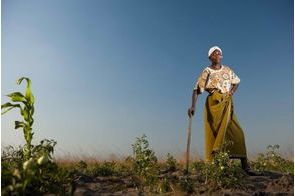Optimising wet period for dry season farming

Summary
Plans for 2024-2025 dry season farming should by now be underway by concerned ministries, including the ministry for agriculture in collaboration with the finance ministry.
Agriculture in many developing countries, including Nigeria, is mainly rain-fed. During wet seasons, when rainfall is relatively high, there is ample supply of water to grow crops, which often contributes to making more food crops available and at cheaper prices when compared with dry seasons. During wet periods, farmers are spared the additional cost of totally relying on irrigation facilities which partly push up the cost of growing crops. As the last dry season, which began last November continued into March this year, the prices of several food items skyrocketed. Between March and June, for example, the price of five tubers of yam was between N25,000.00 and N28,000.00, depending on the size, while a small basket of tomatoes was sold at N15,000.00.
In Nigeria, the rainy season is often expected to begin towards the end of March or early April. But this year, planting of annual and seasonal crops was delayed as the rainy season in most parts of the country was delayed till May. The variation in established weather patterns has been scientifically attributed to climate change, which amongst other things causes high temperatures.
After the rains began this year, rainfall patterns were disrupted and only began to get better in July. As the weather pattern slightly improved in terms of rainfall and new crops are harvested, the availability of food crops increased, and their prices began to fall. Yam, tomatoes, and pepper, amongst other food crops, drove this trend. For example, five big tubers of yam now cost between N10,000.00 and N15,000.00, while a small basket of tomatoes now go for N2,500.00 to N3,500.00.
In rainy or dry season, people must eat. Therefore, as much as possible, food production must be all year round, and farmers must be supported to increase food production to ensure price stability through dry season farming.
Federal and state governments in Nigeria have previously initiated a number of programmes to support dry season farming. In November 2023, the federal government through the Ministry of Agriculture and Food Security unveiled plans to cultivate 123,000 hectares of wheat, 150,000 hectares of rice, 30,000 hectares of maize, and 20,000 hectares of cassava by providing 50 percent input subsidy to farmers.
Plans for 2024-2025 dry season farming should by now be underway by concerned ministries, including the ministry for agriculture in collaboration with the finance ministry, to provide support for irrigation facilities and seedlings that can withstand and thrive with little or no rainfall available to farmers. While such collaborative efforts by government agencies is crucial for food security, smallholders farmers, especially those who may not be able to bear the overall cost of setting up irrigation systems on their farms, need to plan ahead and save water during the wet season – especially around September to early November – to irrigate their farmlands in the dry period when rainfall significantly diminishes.
One way to optimise water availability in wet season is by rainwater collection. Collecting rainwater into underground reservoirs or plastic tanks during heavy rainfalls can help smallholder farmers save the cost of making a borehole or pumping water using power generators in the early periods of the dry season. A farmer can place several plastic tanks of capacities ranging from 5,000 to 10,000 litres on elevated floor and systematically, through drip irrigation holes, channel the water to growing crops. Solar-powered pumping machines can also reduce the cost of pumping water if a well is available to supplement collected rainwater. Cutting the cost of irrigating crops through rainwater collection could increase profitability and the disposable income of smallholder farmers.
Crops that are ideal for dry season planting include tomatoes, pepper, cucumber, okra, watermelon, sweet melon, spinach, some other green vegetables, and beans. This is because early maturing crops are more preferable to economise water use. Early maturing maize that requires 40-60 days, cucumber that matures in six weeks, improved early maturing varieties of sweet melon and watermelon requiring 65-75 days are very appropriate so that collected rainwater can support the crops to maturity or close to harvest.
Government efforts for dry season farming could include making early maturing crops available to farmers. About 3,000 maize stands on one plot of land will require about 180,000 litres of water for a 60-day period. When these crops are produced at odd times of the year – like dry season – they become very profitable for farmers. And if more farmers can produce crops in dry seasons, consumers will have more food items at affordable prices.
Another way to make the most of rainy season for dry season farming is for farmers to begin planting early to take advantage of the residual moisture in the soil. Farmers can also incorporate organic matters such as animal and poultry manures, chipped bark, decomposed cardboard paper, fallen leaves, and other mulching agents in the soil to improve soil water retention capacity and support plant growth.
To boost food production in dry seasons, government and concerned agencies need to look into reviving river basins in the country. Reviving the River Basin Development Authorities in Nigeria could help farmers overcome irrigation challenges in dry seasons and also improve agricultural activities in rural communities. Dams can be very important sources of water for irrigation in dry seasons. They serve as reservoir for water that could have otherwise resulted in flooding. Apart from storing water for agricultural purposes such as irrigation and livestock water supply, dams are also useful for flood control, energy generation, recreation, and pollution control. However, proper maintenance is important to avoid flooding, gully erosion, and landsliding during periods of heavy rainfall.
Reviving and re-organising the 12 river basins in the country – the Upper Benue basin, Lake Chad basin, Benin-Owena basin, Sokoto-Rima basin, Hadejia-Jema’are basin, Cross River basin, lower Benue basin, Upper Niger basin, Lower Niger basin, Ogun-Osun basin, Anambra-Imo basin, and Niger Delta basin – operating in different geo-morphological zones can also reduce the reoccurring loss of crops and farmlands to flooding episodes while providing water to boost year-round farming.
Based on the history of success of the basin authorities during their active years, repositioning them to make them more relevant in meeting the needs of farmers will ease farmers’ access to resources for dry season farming. Collaborations of basin authorities with large agricultural institutes and relevant government agencies to obtain optimal effectiveness of the river basins should contribute to creating a powerful synergy for food security in Nigeria.
Improving farmers’ access to extension services in the country, with better service delivery on the part of extension workers through adequate funding for their activities, is another useful tactic to enable farmers make the best of rainy months in preparation for dry season planting. Extension agents can connect with farmers in both rural and urban communities where agricultural activities take place to provide expert advice and technical know-how to enable farmers navigate the rainy and dry seasons optimally. Functional extension service system can as well provide useful information and help farmers access available support and resources from governmental and non-governmental agencies for greater productivity irrespective of season.
As more efforts are geared towards increasing farmers’ productivity and food production as a whole, processing and storage facilities are highly important to avoid wastage of limited resources (entrepreneurship, labour, and finance) that go into food production. Perishable farm produces that are not taken up immediately through purchase can be dried mechanically or converted into powdery form to increase their shelf life. Again, processing and storage facilities need to be factored into government’s plan to ensure food availability and affordability during dry seasons.
Mojisola Karigidi, PhD, a Financial Nigeria Columnist, is a Nigerian biochemist and the founder and product developer at Moepelorse Bio Resources. She is also a Global Innovation Through Science and Technology (GIST) awardee, and an Aspen New Voices fellow.
Related
-
African leaders prioritise policies to support youth and women
The aim of the UN Food Systems Summit is to deliver progress on all 17 of the SDGs through a food systems approach.
-
The need for women entrepreneurs, innovators and leaders in Africa’s agriculture
Women contribute on the average 40 per cent labour participation in the agriculture sector in sub-Saharan Africa. ...
-
Redirecting agricultural subsidies for a sustainable food future
Public agricultural funding should focus on mitigation and synergies between reducing emissions and producing more food.










